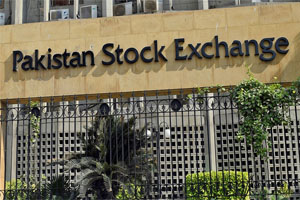
Pakistan's economy may return to positive trajectory this month
The six-month-long cycle of economic contraction may end soon, as the Ministry of Finance has predicted positive economic growth in July and also sees an uptick in inflation due to the hike in petroleum product prices. In its two separate monthly publications, the Economic Update and Economic Outlook July, the Finance Ministry on July 27 gave a round-up of the last fiscal year and also made a forecast of the new 2020-21 fiscal year, which began this month. Based on the Monthly Economic Indicator (MEI), “We expect positive growth in July 2020, indicating a restart of economic activities”, according to the Finance Ministry. If the prevalence of Covid-19 cases slows down further, economic activities will come to a normal level, stated the Finance Ministry. However, risk is associated with the level of public conformity with Standard Operating Procedures (SOPs) that are intended to prevent the pandemic’s spread, it added. The MEI is based on a combination of the monthly data of three variables (large scale manufacturing (LSM) year -on- year growth, money supply (M2) growth adjusted for inflation, and the weighted average Composite Leading Indicator (CLI) in the main trading areas. Pakistan does not report economic growth figures on a quarterly basis, unlike other countries. Its assessment of a positive growth rate is based on the three monthly indicators. A new Ipsos survey for the month of June showed that unemployment remained the most worrisome issue for 86% of the respondents and only 3% of them saw the economy heading in the right direction. The Finance Ministry said that, in the previous fiscal year, there was small but positive growth of about 1% in the first quarter. The economic growth accelerated in the second quarter to 2.58%. But it turned negative in the third quarter of the last fiscal year by 0.19% following the COVID-19 pandemic. In the fourth quarter, the economy contracted 4.9%
|
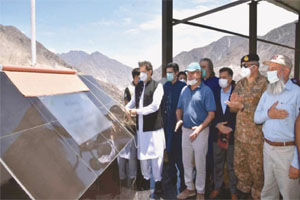
Construction of Diamer-Bhasha dam launched
Prime Minister Imran Khan on July 15 launched the construction of Diamer-Bhasha Dam and announced that the government would move towards building more dams on rivers to generate low-cost hydel power. The 6.4 million acre feet water reservoir would not only add 1.2m acres of agriculture and 4,500 megawatts environment-friendly electricity, it would also boost steel, cement and construction industry by creating 16,000 jobs., said Special Assistant to the PM on Information and Broadcasting in a tweet.
|
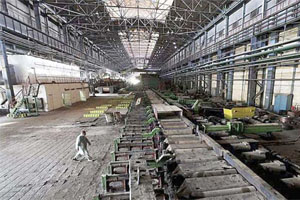
Three companies from China and Russia keen to buy PSM
Chinese and Russian companies have entered the race for investment in Pakistan Steel Mills (PSM) in order to run it on the public-private partnership mode. Briefing the Senate Committee on Industries and Production, Federal Minister for Industries ruled out the privatisation of PSM and vowed to operate it as a joint venture by holding an open bidding at the end of current year. He said the industries ministry had been in contact with 12 international companies to make the steel mill operational and representatives of six companies had so far visited the mill. Out of those six companies, three were keen to purchase the steel mill, he said, adding that the companies were from China and Russia. The steel mill could only be bought by an international company since local investors lacked the capability to do so. “An investment of over $1 billion is required to run the mill,” Senate body was told. “If organisations like PSM are to be kept under government control, then we have to make some big decisions, and the PTI government has decided to run the mill in collaboration with private enterprises,” he added.
|
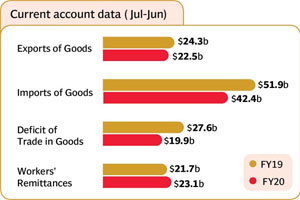
Pakistan's current account deficit contracts 78%
The current account deficit - difference between the government’s higher foreign expenditure and lower income - narrowed by a massive 78% to $2.96 billion in the previous fiscal year ended June 30. The current account deficit shrank to 1.1% of gross domestic product (GDP) in FY20 compared to 4.8% ($13.43 billion) in FY19, the State Bank of Pakistan (SBP) reported on Tuesday. The deficit of $2.96 billion is the lowest in five years. The number improved after the government revised upward the previous month’s (May) current account surplus to $344 million compared to the initially reported $13 million. The much-needed improvement in the current account deficit in FY20, however, was initially achieved by compromising economic growth. Later, the Covid-19 outbreak slowed down the economy further and caused negative growth for the first time in 68 years. In dollar value, the gross domestic product (GDP) contracted 5.22% to $263.80 billion in FY20 compared to $278.36 billion in FY19, the central bank reported. The value of GDP in terms of dollar, however, does not truly reflect the growth pattern. Pakistan actually measures economic production in rupee terms and converts that into dollar value. The volatility in the rupee-dollar exchange rate caused a sharp difference between GDP growth in terms of dollar and actual growth in rupee value. Earlier, the government had provisionally reported an economic contraction of 0.38% for the first time in the past 68 years.
|
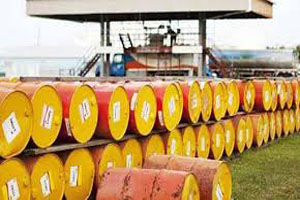
Fuel imports plunge 28pc in FY20
Petroleum imports declined 27.84 per cent in FY20 owing to a steep reduction in domestic demand as a result of lockdowns across the country. It is estimated that petroleum consumption since March 22 has fallen significantly since the full lockdown was enforced and private transport came to a standstill. Data compiled by the Pakistan Bureau of Statistics (PBS) showed the total import bill of fuel group dipped by 27.84pc year-on-year to $10.42bn. Of these, petroleum product imports declined by 24.54pc in value despite increasing by 3.7pc in quantity. Similarly, import of crude oil decreased 40.44pc in value and 24.54pc in quantity during the outgoing fiscal year while those of Liquefied Natural Gas fell by 20.21pc in value, which would have translated into a relatively lower power production through this fuel. On the other hand, liquefied petroleum gas imports jumped 17.63pc in value in FY20, largely to plug a shortage in local production. The dip in local petroleum production and exports from the country has dragged down economic growth as the oil import bill also witnessed a double-digit decline.
|
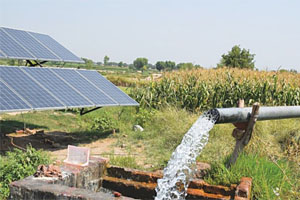
SBP doubles financing for wind, solar energy
The State Bank of Pakistan (SBP) has doubled the scope of its Renewable Energy Refinancing Scheme from Rs1 billion to Rs2bn to help address the challenges of energy shortages and climate change in the country. The SBP said it has enhanced the scope of its refinance scheme by allowing financing under category III to solar and wind-based energy sale companies. The bank said the project size established by the vendor or energy sale company has now been enhanced from 1MW to 5MW. “The cumulative financing limit has also been increased from Rs1bn to Rs2bn,” it said while adding that the decision was taken in light of the feedback received from stakeholders. The SBP Financing Scheme for Renewable Energy was announced in June 2016 with an aim to help address energy shortages and climate change in the country. The scheme was initially divided in two categories, with the first category allowing financing for renewable energy power projects with capacity ranging from 1-50MW for own use or selling to the national grid or combination of both. The second category allowed financing to domestic, agriculture, commercial and industrial borrowers for installation of renewable energy-based projects of up to 1MW to generate electricity for own use or selling to the grid or distribution company under net metering. Later, in July 2019, the SBP introduced category III to facilitate financing to vendors and suppliers for installation of wind and solar systems of up to 1MW. Since the introduction of the scheme, total outstanding financing under the scheme has reached to Rs5.6bn for 217 projects having potential of adding 292MW of energy supply as per SBP.
|

Textile exports decline 6pc to $12.5bn
Pakistan’s textile and clothing exports posted a negative growth of over six per cent year-on-year to $12.526 billion in the fiscal year 2019-20 compared to $13.327bn in the corresponding period last year, data released by the Pakistan Bureau of Statistics showed. The pace of fall in textile exports slowed down in the last two months owing to a recovery in the international orders. Compared to 36.5pc decline in May, exports in June declined by 5.43pc over the last year. The easing of lockdown in the North American and European countries — top export destinations for Pakistani textile goods are expected to help revive the sinking exports. The Covid-19 has collapsed the demand for the country’s exports during the last five months. Piled up containers at ports since March 22 were mostly cleared in the month of June. Moreover, the government also reopened exports through the land route to Iran and Afghanistan in June. A report produced by the customs authorities — who compile export data from good declaration forms — showed that cargo handling at Karachi ports posted a growth of 7.23pc in June as 49,953 export containers were shipped this year as against 46,583 of last year. It clearly shows that exports picked up in the month of June from a year ago. However, exports are expected to revive in July as exporters have resumed production to honor their international orders. Exporters are already receiving inquiries about personal protective equipment from foreign buyers as the government allowed exports of disposable gowns, disposable gloves, face shields, biohazard bags, goggles, shoe covers and hand sanitisers with immediate effect. Previously, the government allowed exports of textile masks as well.
|

Pakistan's LSM sector shrinks 10.3% in Jul-May FY20
Large-scale manufacturing (LSM) output shrank 10.3% in July-May of fiscal year 2019-20 over the same time of previous year, the Pakistan Bureau of Statistics (PBS) reported. The LSM contracted by 24.8% in May alone over the same month a year ago, stated the national data-collecting agency. On a month-on-month basis, the LSM posted a positive growth of 20.5% in May 2020 over April due to better output in fertiliser and pharmaceutical sectors. But almost all the other big industries faced contraction on a monthly basis too. The respiratory disease, Covid-19, had started impacting Pakistan’s economy from the third week of March this year. But large industries had been struggling even before the pandemic hit the economy. The LSM sector has been shrinking since the start of fiscal year 2019-20, which began in July 2019, due to double-digit interest rate, currency depreciation resulting in a high cost of inputs, higher taxes and increase in electricity and gas prices. After the spread of the disease, the government has conveniently thrown the responsibility on to Covid-19 instead of correcting its economic policies. Pakistan is de-industrialising with the manufacturing sector’s contribution to the gross domestic product (GDP) declining every year. PBS data showed that out of 15 major industries, being assessed by the PBS, only three recorded some growth while output in 12 industries shrank in July-May of fiscal year 2019-20.
|
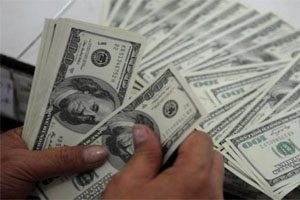
Profit repatriation by foreign firms drops 35% to $1.35b
Foreign firms and individual investors repatriated profits amounting to $1.35 billion to their headquarters and homeland in fiscal year ended June 30, 2020, according to Pakistan’s central bank. The outflow from the country was 35% lower compared to the $1.83 billion repatriated in the prior fiscal year, the State Bank of Pakistan (SBP) reported. However, the foreigners, who invested in transport, chemical and tourism sectors, managed to send back comparatively higher profits in FY20 compared to the prior year. A significant depreciation of the rupee against the US dollar (especially since the Covid-19 outbreak in late February in Pakistan) has partly caused the drop in repatriation in FY20. Apart from that, low earnings due to Covid-19 and slowdown in domestic economic activities before the pandemic prevented investors from repatriating higher profits. Multinational companies (MNCs) earned profit on long-term investments in different sectors of the economy like power projects, fast moving consumer goods, textile manufacturing, banks, chemicals and various other manufacturing sectors. Similarly, foreign asset management companies, foreign funds and foreign individual investors made profit through receipt of dividends from listed companies at the Pakistan Stock Exchange (PSX) and appreciation in share prices at the bourse. Another factor behind low repatriation may be that the investors opted to reinvest the profit in Pakistan instead of sending it to their headquarters.
|
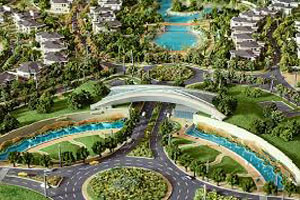
Punjab to develop Pakistan’s largest SEZ
The Punjab government has decided to establish the largest Special Economic Zone (SEZ) of the country in Chaubara along the Muzaffargarh-Layyah road to boost economic activity in the underprivileged areas of South Punjab. Ministry of Industry and Commerce has prepared a plan of action for the establishment of the mega SEZ, which will be developed on area covering 20,000 acres. Official sources said the SEZ can be expanded up to 50,000 acres in the future, if needed. Owing to the global economic meltdown as result of the coronavirus pandemic, a large number of expat workers are expected to return to Pakistan, therefore, the government has prepared a plan to accommodate the workforce in the economic zone in addition to creating jobs for locals.
|
|

© 2020 Alpine Marine Services Private Limited
all rights reserved
|
|
|